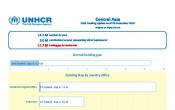Tajikistan
Operation: Tajikistan
Location
{"longitude":71,"latitude":39,"zoom_level":7}
Latest update of camps and office locations 21 Nov 2016. By clicking on the icons on the map, additional information is displayed.
Key Figures
| 2017 planning figures | |
| 800 | people of concern receive legal assistance |
| 600 | children will be enrolled in primary education |
| 120 | people of concern will be registered in job placement services |
| 90% | of stateless people for whom nationality will be granted or confirmed |
| 88% | of stateless people will have a birth certificate |
| 2015 end-year results | |
| 823 | people of concern received medical assistance from local clinics and hospitals |
| 101 | Afghan refugees repatriated |
| 90% | of registered refugee children were enrolled in primary school (566) and secondary school (218) |
People of Concern
507%
Increase in
2015
2015
| 2015 | 21,779 |
| 2014 | 3,590 |
| 2013 | 5,683 |

[["Refugees",1969],["Asylum-seekers",288],["Stateless",19469],["Others of concern",53]]
Loading ...
Budgets and Expenditure for Tajikistan
< Back
2015
{"categories":[2012,2013,2014,2015,2016,2017],"budget":[1.88119017,1.94284773,2.10636372,2.71827858,4.06714081,2.347732335],"expenditure":[1.23233116,1.27120087,1.60379214,1.73002601,null,null]}
{"categories":[2012,2013,2014,2015,2016,2017],"p1":[1.78267185,1.81367891,1.91788552,2.18001327,2.46243189,1.577403333],"p2":[0.09851832,0.12916882,0.1884782,0.53826531,1.60470892,0.770329002],"p3":[null,null,null,null,null,null],"p4":[null,null,null,null,null,null]}
{"categories":[2012,2013,2014,2015,2016,2017],"p1":[1.13603062,1.18003574,1.41910777,1.25514683,null,null],"p2":[0.09630054,0.09116513,0.18468437,0.47487918,null,null],"p3":[null,null,null,null,null,null],"p4":[null,null,null,null,null,null]}
Loading ...
CHOOSE A YEAR
- 2015
- 2017
Working environment
The Republic of Tajikistan sits at the crossroads between Afghanistan and Central Asia, and the operational context is largely shaped by the region’s complex geopolitics. As of September 2016, Tajikistan hosted some 2,500 refugees and 400 asylum-seekers and the total number of people with undetermined nationality registered in three pilot regions rose to 22,850 people, representing a fraction of the stateless population in the country.In the south of the country, Tajikistan shares a long border with Afghanistan. In recent years, north-eastern Afghanistan has become an epicentre for increased insurgent activity, notably in Kunduz Province where the situation remains highly volatile. In the last seven months of 2016, over 800 new Afghan asylum-seekers arrived in Tajikistan, representing a significant spike in the rate of new arrivals in recent years. In regard to possible population displacement and influx of refugees from Afghanistan, UNHCR is working on an inter-agency contingency plan.
In the north of the country, Tajikistan forms part of the ethnically complex and historically volatile Fergana Valley, sharing an intricate web of borders, often disputed, with Kyrgyzstan and Uzbekistan. While Tajikistan’s internal security context remains stable and reasonably safe, the Government’s increasing focus on fighting domestic terrorism, often unclearly defined, has impacted the already fragile protection space for refugees and stateless people. Access to territory and sustainable livelihoods for refugees continue to be a challenge. Given the complexity of the statelessness issue and political challenges, addressing it will require UNHCR’s engagement for another 2-4 years with sustained resources.
Key priorities
In 2017, UNHCR’s operation in Tajikistan will focus on three strategic priorities:• Strengthening the national asylum system and emergency preparedness, with a focus on Afghanistan;
• Achieving solutions for refugees, with an emphasis on local integration;
• Reducing and preventing statelessness.
UNHCR seeks to strengthen partnerships with the Government on border management and asylum procedures while moving towards phased disengagement in certain sectors, focussing efforts on livelihoods and alterative stay arrangements. In addressing statelessness, prioritized activities will include technical, legal and institution-building support to the Government of Tajikistan to implement existing and new legal provisions (Statelessness Conventions, Constitutional Law, Implementing regulations and Amnesty Law), and the National Action Plan on Addressing Statelessness aiming to achieve solutions for all people at risk of statelessness.
At the country level, the Office will focus on leveraging inter-agency partnerships to mainstream people of concern into existing partners’ programmes. Special efforts will be made to exploit inter-agency synergies in the context of National Development Strategy. The Office will also support key NGO partners to mobilise resources independently by advocating for direct donor funding.
Additional funds if secured would primarily be used for small-scale infrastructure projects and community-based initiatives in the context of peaceful coexistence and local integration.

